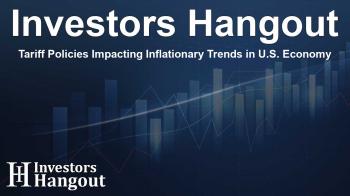Tariff Policies Impacting Inflationary Trends in U.S. Economy

Rising Inflation: The Toll of Tariffs
Concerns about inflation driven by recent tariff policies have come to the forefront. U.S. businesses are clearly indicating that price pressures are intensifying, signaling a resurgence of inflation.
Latest Economic Indicators Raise Alarm
The July Purchasing Managers’ Index for services revealed alarming trends. It suggested that input prices surged at the fastest rate since late 2022, intensifying worries that the tariff strategies implemented during Donald Trump’s presidency are beginning to have a noticeable impact.
Details of the Economic Data
The ISM Services Prices Index reported a jump to 69.9% in July, compared to 67.5% in June, marking the highest figures since November 2022. This increase in costs coincides with signs of stagnation within other economic metrics.
Such indicators hint that the economy could be entering a stagflation period, characterized by sluggish growth paired with rising prices, which poses significant challenges for policymakers.
Growth Slowing: Employment Figures Deteriorate
The broader ISM services index saw a decline from 50.8% in June to 50.1% in July, falling short of economic forecasts. The Business Activity Index decreased to 52.6%, while New Orders also experienced a drop.
Employment metrics were equally troubling, with the ISM Services Employment Index dropping to 46.4%, reflecting an alarming contraction in job creation. This decline aligns with reports of reduced nonfarm payroll growth.
The Impact of Employment Declines on Inflation
As employment figures weaken, concerns grow regarding the Fed's capacity to maintain stable prices while maximizing employment opportunities. Economic indicators portray a stark picture where rising inflation is coupled with a softening job market.
Expert Opinions on Current Trends
Analysts like Steve Miller from ISM have observed sluggish growth alongside increased input costs, depicting an environment filled with uncertainty. The latest data show that both the New Exports and Imports indexes have shifted from growth to contraction, indicating tariff tensions are influencing global trade.
Some survey participants have noted increased congestion in transportation and a variety of commodities witnessing price increases, contributing to extended delivery times and heightened cost dynamics across different service sectors.
Ryan Sweet, Chief U.S. Economist at Oxford Economics, has emphasized the risks observed in July’s data, which suggest that the economy faces further slowdowns alongside rising inflation driven partially by tariffs.
Market Reaction to Economic Alerts
The financial markets mirrored this cautious sentiment. The S&P 500 saw a decline of 0.3% in early trading on the given day, while the Nasdaq also faced slight contractions fortified by strong performance within some sectors, particularly in tech stocks like Palantir Technologies Inc (PLTR) which demonstrated resilient growth despite broader market concerns.
Precious metals have also reacted sharply to inflation forecasts, with gold and silver experiencing price upticks as investors seek safe havens amidst rising uncertainties.
Conclusion: Navigating a Complex Economic Landscape
With the outlook for the economy increasingly complicated by tariff-related inflation, businesses are left to navigate a scenario filled with rising costs and potential stagnation in growth. Maintaining a balance will be crucial in overcoming these challenges and ensuring economic stability.
Frequently Asked Questions
What are the recent trends in inflation due to tariffs?
Recent economic indicators show rising input prices and inflationary concerns fueled by tariff impacts, putting pressure on various sectors.
How does the ISM Services Index reflect economic health?
The ISM Services Index indicates shifts in business activity and prices, providing insight into potential stagnation and inflation risks.
What is stagflation and how does it relate to current economic conditions?
Stagflation describes a period of slow economic growth combined with high inflation and is a growing concern given the recent data.
What are analysts saying about employment trends?
Analysts highlight a rapid deterioration in employment metrics, reflecting a challenging landscape for job creation amidst rising inflation.
How have financial markets reacted to economic warnings?
Financial markets exhibited caution, with notable declines in major indices as investors react to signals of economic instability and inflation.
About The Author
Contact Owen Jenkins privately here. Or send an email with ATTN: Owen Jenkins as the subject to contact@investorshangout.com.
About Investors Hangout
Investors Hangout is a leading online stock forum for financial discussion and learning, offering a wide range of free tools and resources. It draws in traders of all levels, who exchange market knowledge, investigate trading tactics, and keep an eye on industry developments in real time. Featuring financial articles, stock message boards, quotes, charts, company profiles, and live news updates. Through cooperative learning and a wealth of informational resources, it helps users from novices creating their first portfolios to experts honing their techniques. Join Investors Hangout today: https://investorshangout.com/
The content of this article is based on factual, publicly available information and does not represent legal, financial, or investment advice. Investors Hangout does not offer financial advice, and the author is not a licensed financial advisor. Consult a qualified advisor before making any financial or investment decisions based on this article. This article should not be considered advice to purchase, sell, or hold any securities or other investments. If any of the material provided here is inaccurate, please contact us for corrections.

